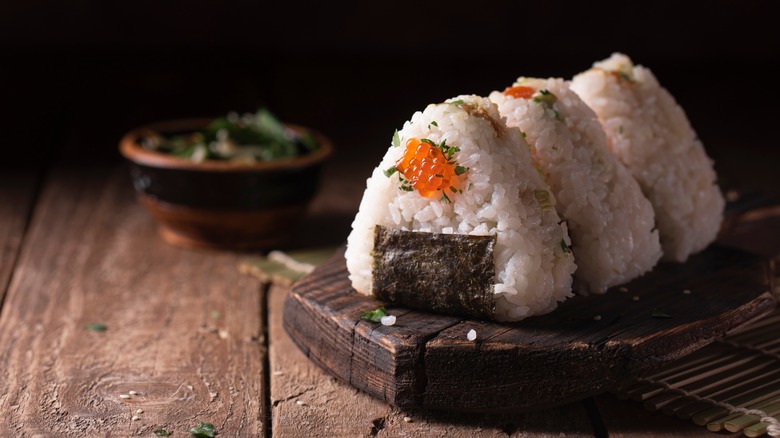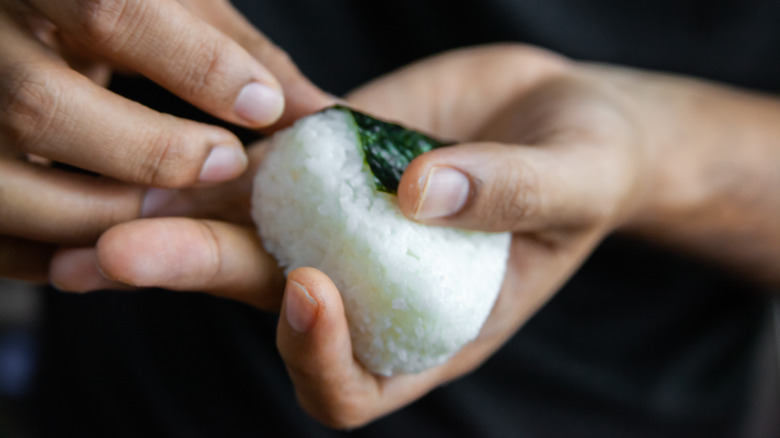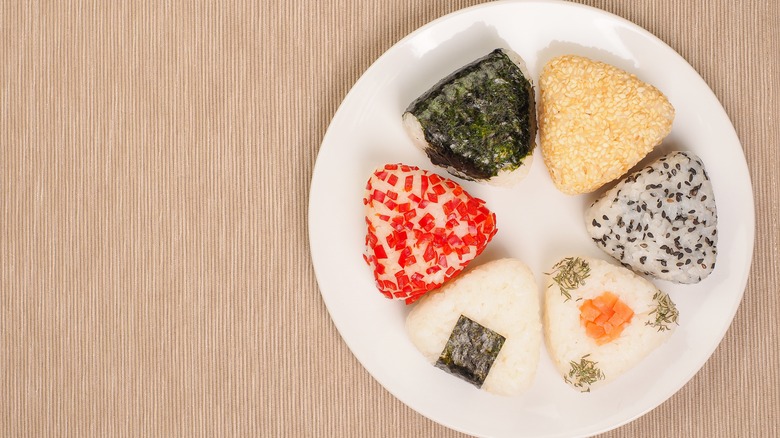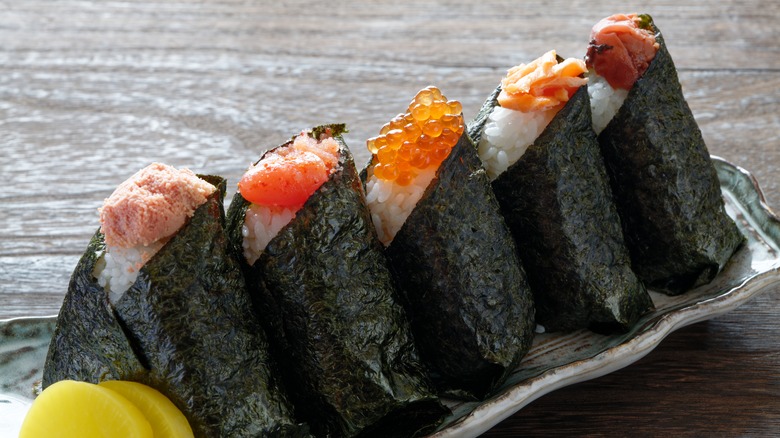What Exactly Is Onigiri?
If you've ever visited Japan, spent some time on bento box Tik Tok, or watched any anime, there's a good chance you've encountered the Japanese rice balls known as Onigiri or Omusubi (via Just One Cookbook). These tasty treats are a simple snack that can be frequently found in Japanese konbini (convenience stores), at home, in bento boxes, or at Japanese Izakaya restaurants.
By Food notes that onigiri in their simplest form are balls of rice with a flavorful, and most often savory, filling. From this base they can then be wrapped in nori (dried seaweed), dressed in black sesame seeds or other seasonings, or even grilled. One of the reasons that onigiri are so popular is that they are so easily customizable. They are also incredibly portable and can be taken on picnics, trains, or enjoyed as a quick lunch.
According to Tensuke, there is evidence that onigiri were first made as a way to preserve and transport rice easily. Using heavily seasoned or pickled fillings and coating the balls with salt helped to preserve rice for easy consumption. Shaping them into balls also made them portable and easy to carry in dried bamboo leaves like lunchboxes or early bento (via My Healthy Japan). They were such great, portable snacks that soldiers often relied on them as rations during the Sengoku period (1467-1507).
How to make onigiri
Onigiri seem to be among the most popular foods in anime as well, they've appeared in "Pokémon," "Cooking with Valkyries," the Oscar-winning film "Spirited Away," and countless others. They're also mentioned frequently in spirit on the show "Jujutsu Kaisen" where the character Toge Inumaki can only safely speak by naming different onigiri fillings (via Anime Hunch). Luckily, there are a lot of fillings out there for him to use to express himself.
According to By Food, onigiri are simple enough, but their diverse fillings give them tons of flavor to please almost any palate. Among the most popular are salmon, tuna with mayonnaise, and umeboshi, which are Japanese pickled plums, but there are plenty of other options out there too, per Chopstick Chronicles.
Onigiri is assembled by taking freshly made rice, and forming a small patty. Then place the filling inside before forming another rice patty on top. Seal the edges of the rice so the filling doesn't leak out, and then shape it into a ball, rounded triangle, or any other shape you'd like. It's important to also keep your hands wet to prevent the rice from sticking too much, and also add some salt to your hands to season the rice while it's shaped. When you're ready to eat, add a slice of crisp nori or sesame seeds. Just One Cookbook notes it's important to add a piece of filling to the top so that each flavor can be identified.
What does onigiri taste like
The flavor of onigiri is mostly dependent on its filling. The white rice is most often only lightly seasoned with some salt, so it can taste bland. Bold flavors are often added as fillings to help counter this the same way that rich meats and sauces are paired with simple white bread for sandwiches (via Binging with Babish). The nori also adds a salty, crisp bite to the exterior, but the fillings are definitely the stars of the show.
One classic flavor is the umeboshi or Japanese pickled plum. According to Eat This, Not That! they have a sour, salty, bite that pairs well with the rice's simplicity. The more conventional salmon or tuna mayonnaise on the other hand are classic, savory, and creamy fillings, per Chopstick Chronicles.
Onigiri are really a template though. The rice can be seasoned with spice mixes like furikake (nori, bonito flakes, sesame seeds, and salt) or shichimi togarashi (ground sesame seeds, chile, and orange peels) which will add new dimensions to every bite. They can also be grilled for a caramelized exterior, or made with different blends of rice (via Books and Bao). The nori wrapping can also be easily swapped out for shiso leaves, kelp, or pickled napa cabbage leaves.
Are onigiri nutritious?
Onigiri are packed with nutrition. They're most often made as nutrient dense snacks, and can even sub in for a meal the same way some Americans reach for an energy bar according to Just One Cookbook. Aspire Fitness notes that the rice shell is mostly carbohydrates, and contains little protein, but many of the other nutrition facts are dependent on the type of wrap or filling used. Nori is full of great nutrition, but isn't often eaten in large enough amounts to be considered a valuable source. According to Precision Nutrition, ten sheets of nori contain only 9 calories, 1.5 grams of protein, and 1.3 grams of carbohydrates. It also often contains iodine, vitamin C, potassium, vitamin A, magnesium, calcium, iron, zinc, and even vitamin B12. A great way to get the most of this nutrition is to make onigirazu, which is a variation of onigiri that resembles a wrap using an entire nori sheet.
The fillings can be a great source of nutrition as well (via Aspire Fitness). Tuna and salmon are both well loved for their low calorie content, high protein, and healthy fats. Umeboshi are also a great low calorie option, though they are lacking in other valuable nutrients. Chicken onigiri are another low calorie and nutrient dense option, though it may depend on how the meat is prepared.



